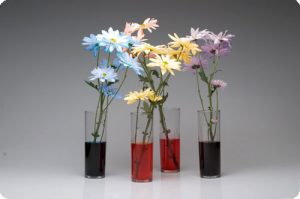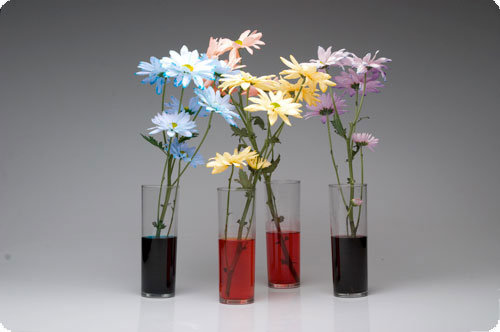Flowers that change color make an interesting science fair project for kids to understand the method by which plants absorb their food and water from the ground. The magical color change of white flowers is going to leave the young minds awestruck. However, once they know the reason behind it, it will seem to be a normal affair.

Color Changing Flowers Experiment
Hypothesis
On immersing the stems of white flowers in food coloring solutions, the petals will be seen to change their color.
Supplies
- 5 white flowers with long stems without any leaves (carnations, daisies, roses or chrysanthemums work well)
- Water
- Food coloring in 5 different colors (You may take red, green, blue, yellow and purple)
- 5 mini containers or jars
- Sharp scissors
Steps
- Add half a cup of clean water and 10 drops of food coloring to each jar so that each of them has a different color than the others.
- Cut off the ends of the stems such that about 6 inches of the stems are still left attached to the flowers.
- Place one flower in each jar.
- Leave the jars in a safe place with ample sunlight for about a week.
- Every 3 days, snip off a tiny bit from the ends of the stems to aid in the absorption process of the colored water by the flowers.
- Make your observations at the end of the 1 week period.
You will observe that the white flowers get the color on their petals in which they are dipped. However, there are a few colors like purple that get less absorbed than the other colors like blue and red.
Video on Flowers Changing Color
Why Does The Color Change?
This experiment visually demonstrates how the stems help in carrying water and nutrients from the ground to the higher parts of a plant like the flowers. This “sucking” action is a combination of 2 different physical phenomena. One is transpiration and another is cohesion. Transpiration is the slow evaporation of water from the upper parts of a plant like leaves, flowers and buds. As the upper water molecules are pulled up owing to the above, those molecules that lie further down move up to take their place due to cohesion, that is, the force of attraction between similar particles.
The process resembles the sucking up of a liquid by a straw. Instead of the mouth here we have the sucking action of transpiration. This phenomenon is known as capillary action as the water flows up through narrow tubes or capillaries in the stem called xylem. After the color change, if you split open the stems with a sharp blade, you can observe the colored (originally colorless) tubes running throughout its length. The celery experiment is based on the same principle.
A proper project abstract, method, conclusion and a good research to gather background information are the key ingredients to make this science fair experiment a success. The natural color change is pretty quick and can be seen to start just within an hour of placing the flowers in the food dye.

Leave a Reply